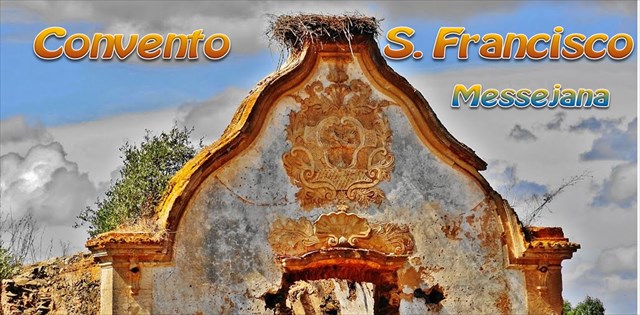
 Bem vindo/a a esta cache que o leva a conhecer o antigo Convento de S. Francisco na Messejana.
Bem vindo/a a esta cache que o leva a conhecer o antigo Convento de S. Francisco na Messejana.
Uma jóia da arquitetura religiosa alentejana, hoje em ruínas, mas ainda com muitos sinais e pormenores construtivos assinaláveis que nos mostram o que seria este convento. Venha daí!
![[EN]](https://imgproxy.geocaching.com/26dce0e20e21dd7e2c84c6c439fc1ab0a1b1385f?url=http%3A%2F%2Ffarm1.static.flickr.com%2F179%2F481411263_e6595005a4_o.gif) Welcome to this cache that takes you to meet the former Convent of St. Francis in Messejana..
Welcome to this cache that takes you to meet the former Convent of St. Francis in Messejana..
A jewel of religious architecture Alentejo, now in ruins, but with many signs and constructive remarkable details that show us what is this convent. Come on!
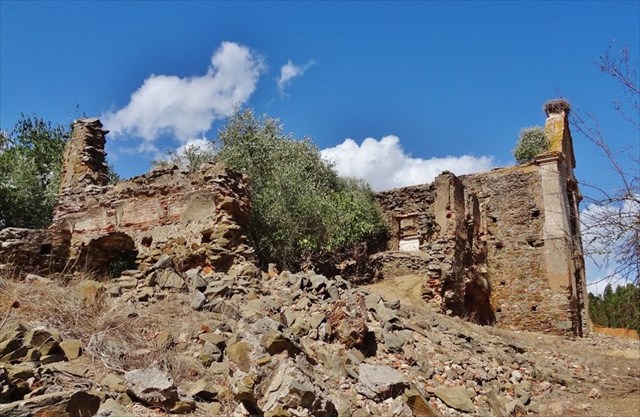
![[PT]](https://imgproxy.geocaching.com/fd803be3bfb7396e826555e469c7752394fb37ae?url=http%3A%2F%2Ffarm1.static.flickr.com%2F212%2F481411265_8928121d68_o.gif) A História do Convento
A História do Convento
A informação sobre este convento é escassa. Sabe-se que foi um convento de franciscanos, fundado por D. Lourenço da Silva, com a denominação de Convento de Nossa Senhora da Conceição dos Xabreganos, em 1566 ou 1567. No século XVII o convento tinha um dormitório, uma sacristia e algumas oficinas. Na igreja existiam duas capelas laterais e uma terceira junto à sacristia. Também é denominado Convento Franciscano de N. Sra da Piedade.
Coloca-se a hipótese de que no anterior local do Convento tenha existido uma capela ou eremitério e que os Frades da Ordem Terceira aí tenham vivido. Além disso os Terceiros encontravam-se juridicamente submetidos aos frades menores, tendo o Papa, Pio V, em 1568, através da Bula "Ea est officir” sujeitado os terceiros Regulares ao governo da Observância. Devido a este contexto histórico religioso não parecerá estranha a implantação de um Convento de Frades da Regular Observância, em Messejana, local onde os Terceiros já se encontravam anteriormente.
Um texto antigo relata: "Em 1566 é fundado o Convento de Nossa Senhora da Piedade, da Ordem de S. Francisco da Seráfica Observância dos Algarves, nos arredores da Vila de Messejana. Estes frades recoleítos propunham-se à mais estreita observância da regra seráfica, a "strictioris observantiae", devendo observar o retiro e o recolhimento".
A fundação deste convento encontra-se envolta numa lenda. Esta relata que estando D. Lourenço da Silva, Fidalgo do Concelho do reí D. Sebastião, primeiro Regedor das Justiças dos Reinos de Portugal e dos da sua linhagem, Comendador da Igreja da Vila de Messejana e fundador da Igreja da Misericórdia dessa vila, ou em alternativa um filho seu, prisioneiro dos mouros, ocorreu uma situação que deu origem à concessão do terreno e dinheiro para a construção do convento. Estando a mulher e as filhas de D. Lourenço da Silva a colocar num cofre o resgate exigido pelos infiéis, a filha mais nova exprime o desejo de que com parte desse dinheiro se fundasse, na Quinta da Piedade de Messejana, um convento para os frades recoleitos de Xabregas. Logo se ouviu o ruído de correntes a serem arrastadas. O cativo encontrava-se no meio do pátio da casa, tendo o mesmo relatado que dois religiosos lhe tinham aparecido e, como por milagre, sentira-se ser transportado para casa. Assim D. Lourenço da Silva resolveu fundar o referido convento. Outra lenda, relacionada com um sino do convento, de grandes dimensões, relata que este estava para ser transportado, numa armada de D. Sebastião, até África. Achando o rei que era grande demais, D. Lourenço da Silva ofereceu-lhe um que possuía na sua Quinta do Estoril, termo da Vila de Cascais. O monarca ofereceu-lhe, então, o primeiro sino, o qual apresentava as armas reais e uma inscrição "Eu EI Rey D. Sebastião com o sino".
O Papa Pio V concedeu, em 1566, ao Convento de Nossa Senhora da Piedade, de Messejana, a Bula "Ineffabilia Gloriose", a qual concedia indulgências a quem visitasse a Igreja de mesmo orago, durante a festa da Anunciação, entre o meio-dia da véspera e a meia-noite daquele dia.
Em 1719 tem-se conhecimento de que o convento possuía um cárcere, pois para ele havia sido exilado, por razões não referidas, "Fr. Francisco da Visitação, pelo tempo de dez anos, devendo permanecer em reclusão durante dois deles".
Em 1834, no âmbito da "Reforma geral eclesiástica" empreendida pelo Ministro e Secretário de Estado, Joaquim António de Aguiar, executada pela Comissão da Reforma Geral do Clero (1833-1837), pelo Decreto de 30 de Maio, foram extintos todos os conventos, mosteiros, colégios, hospícios e casas de religiosos de todas as ordens religiosas, ficando os de religiosas, sujeitos aos respectivos bispos, até à morte do último, data do encerramento definitivo. Os bens foram incorporados nos Próprios da Fazenda Nacional.
A venda do convento e cerca teve lugar após a Portaria do Ministério da fazenda, decretada a 31 de agosto de 1842, tendo sido arrematados por mil e duzentos reis e 405 reis respectivamente. Sabe-se que a Câmara Municipal dirigiu uma pedido ao Ministério da Fazenda com vista à utilização das pedras da igreja para a construção de uma nova casa da câmara, bem como do terreno da cerca para aí se fazer um cemitério. Tudo isto ficou assente na Portaria do Ministério da Fazenda de 7 de junho de 1841.
Hoje o convento é uma triste ruína, mas ainda são bem visíveis o corpo central da igreja, o baptistério (onde se encontram os mais espectaculares trabalhados e restos de azulejos), e o corpo lateral do edifício, onde ainda se encontram algumas dependências e as paredes arruinadas de outras, assim como é visivel a escada de acesso ao 1º andar. Da torre sineira já nada resta, como aparece documentada no desenho abaixo.
O convento insere-se numa propriedade privada, que segundo a informação recolhida é de uma senhora de idade que vive na vila. O Convento apesar de não ser visitável não há problema se o visitarem, desde que não deixem as cancelas do gado abertas. Actualmente está arrendado a um agricultor que o usa para guardar as suas ovelhas.
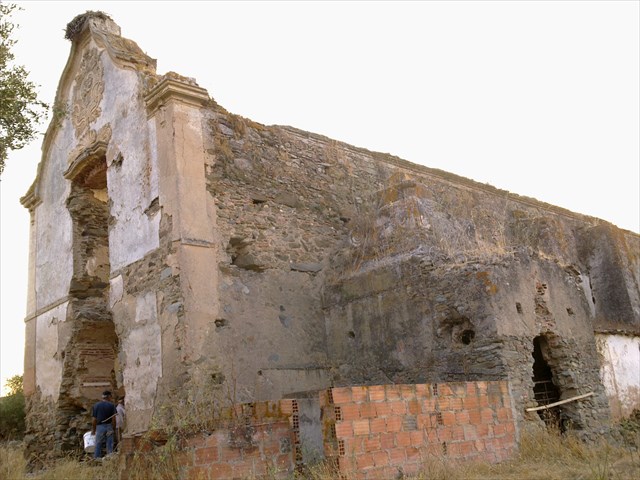
![[EN]](https://imgproxy.geocaching.com/26dce0e20e21dd7e2c84c6c439fc1ab0a1b1385f?url=http%3A%2F%2Ffarm1.static.flickr.com%2F179%2F481411263_e6595005a4_o.gif) The History of the Convent
The History of the Convent
The information on this convent is scarce. It is known that was a Franciscan convent, founded by D. Lourenço da Silva, under the name of Convent of Our Lady of the Conception of Xabreganos in 1566 or 1567. In the seventeenth century the convent had a bedroom, a sacristy and some workshops . In the church there were two side chapels and a third next to the sacristy. It is also called the Franciscan Convent of Our Lady of Mercy.
Raises the hypothesis that the former site of the Convent has been a chapel or hermitage and the Order of Friars Third there have lived. Also the third found themselves legally subject to the Friars Minor, and Pope Pius V, in 1568, by the Bull "Ea est officir" Subjected third Regular Observance of the government. Because of this religious historical context does not seem strange to implementation of a convent of the Regular Observance Friars in Messejana, where the third party were already previously.
An ancient text says:. "In 1566 is founded the Convent of Our Lady of Mercy, of the Order of St. Francis the Seraphic Observance of the Algarve, just outside the village of Messejana These recoleítos friars proposed to the more strict observance of the rule seraphic the "strictioris observantiae", observing the retreat and gathering ".
The foundation of this monastery is shrouded in legend. This reports that being D. Lourenço da Silva, King's County Fidalgo Sebastian, First Ruler of the Justices of the Kingdoms of Portugal and its lineage, Commander of the Church Messejana village and founder of the Church of Mercy this village, or alternatively his child, a prisoner of the Moors, there was a situation which gave rise to the granting of land and money to build the convent. Being the wife and daughters of D. Lourenço da Silva put in a safe rescue required by the infidels, the youngest daughter expresses the hope that with part of that money is founded on the Quinta da Messejana Mercy, a convent for the friars recoleitos of Xabregas. Then she heard the sound of chains being dragged. The captive was in the middle of the courtyard, having the same reported that two religious had appeared to him and, miraculously, felt to be transported home. Thus D. Lourenço da Silva decided to found the said convent. Another legend, related to a convent bell, large reports that this was to be transported in a fleet of Sebastian until Africa. Finding the king that was too large, D. Lourenço da Silva offered him who had in his Quinta do Estoril, term of Cascais. The monarch offered him then the first bell, which showed the royal arms and an inscription "I EI Rey Sebastian with the bell."
Pope Pius V granted in 1566, the Convent of Our Lady of Mercy, Messejana of the Bull "Ineffabilia Gloriose" which granted indulgences to those who visit the church of the same patron saint, during the feast of the Annunciation, between the mid- day of yesterday and midnight of that day.
In 1719 it has been known that the convent had a prison because he had been exiled to, not mentioned reasons, "Fr. Francisco of the Visitation, by the time ten years, and shall remain in seclusion for two of them."
In 1834, under the "general ecclesiastical reform" undertaken by the Minister and Secretary of State, Joaquim António de Aguiar, performed by the Commission for the Clergy General Reform (1833-1837), by the Decree of May 30, all convents were extinct , monasteries, schools, hospices and religious houses of all religious orders, getting the religious, subject to their respective bishops until the death of the latter, date of decommissioning. The property was built in Own the National Treasury.
The sale of the convent and about took place after the Ordinance of the Ministry of the farm, handed down August 31, 1842, having been fetched twelve hundred kings and kings 405 respectively. It is known that the City Council addressed a request to the Ministry of Finance for the use of church stone for the construction of a new house of the camera as well as the land on which there are about to make a cemetery. All this was based on the Ordinance of the Ministry of Finance of June 7, 1841.
Today the monastery is a sad ruin, but are still clearly visible the central body of the church, the baptistery (where the most spectacular worked and tile debris), and the lateral body of the building, where there are still some dependencies and ruined walls of others, as is visible the stairs to the 1st floor. The bell tower has nothing remains, as is documented in the drawing below Mines.
The convent is part of a private property, which according to information gathered is of an old lady who lives in the village. The Convent although not visitable no problem if the visit provided they do not let the the open cattle gates. It is currently leased to a farmer who uses it to save his sheep.

![[PT]](https://imgproxy.geocaching.com/fd803be3bfb7396e826555e469c7752394fb37ae?url=http%3A%2F%2Ffarm1.static.flickr.com%2F212%2F481411265_8928121d68_o.gif) A Cache
A Cache
Esta é uma cache multi de dificuldade baixa, composta por três pontos, dois virtuais mais o final, não é necessário entrar no Convento para encontrar a cache, embora o possa fazer numa abertura do muro junto à cache final e desde que não deixe as cancelas do gado abertas! O arrendatário não se importa que o visitem mas cuidado com as cancelas!
Dirija-se ao ponto inicial da cache e conte o número de "pedras" de lavar a roupa que existem no local. Esse valor é A.
Siga em direção ao ponto intermédio passando em frente ao Convento, aprecie o trabalhado na fachada da igreja e toda a paisagem envolvente. Siga até ao 2º portão e conte as pontas de seta que estão no topo do portão (todas, mesmo que não estejam completas), esse valor é B.
A cache está em N 37° 50.(A-4)(B-7)0 W 008° 14.(B-9)A0
Siga agora para o ponto final, contornando o muro do Convento no sentido contrário aos ponteiros do relógio, logo ao seguir ao ponto intermédio tem um poço de nora, e depois entra numa zona de floresta, até que chega às traseiras do convento. Aí, para além da cache final, tem outra prespectiva do Convento e pode aceder ao mesmo por aí. A decisão é sua e a responsabilidade também. Tenha em atenção às recomendações e cuide do património edificado. Tenha muito cuidado com a estrutura do edifício uma vez que o mesmo está em ruína! Obrigado.
Aproveitem a experiência e partilhem-na connosco, tirem fotos, façam filmes e contem a aventura no vosso log SEM DAR PISTAS SOBRE O CONTAINER p.f.! Obrigado.
A cache tem logbook, stashnote, material de escrita e algumas prendas. Seja cuidadoso no manuseamento do container para que nada se danifique ou perca.
Espero que gostem!:)
Esta cache é um tupperware de tamanho Small de medidas +/- 15x10x8cm.
Deixe-a exactamente como a encontrou, colocando-a também da mesma maneira, no mesmo local e bem fechada. Verifique que não está a ser observado enquanto retira e coloca a cache no sítio. Do seu cuidado depende a boa saúde desta cache. Obrigado.
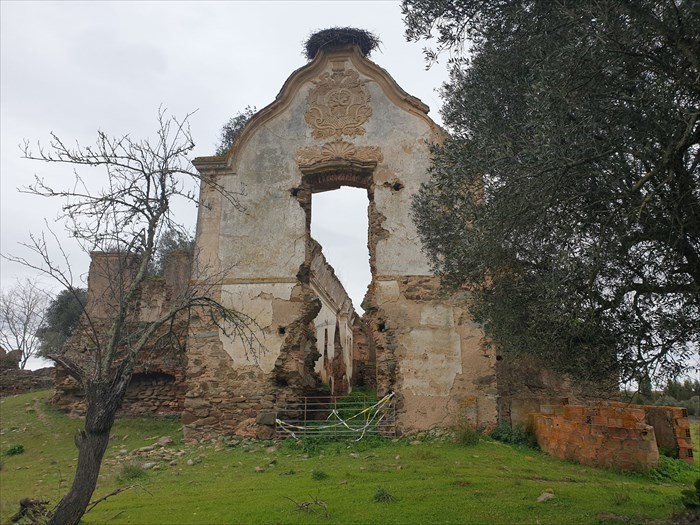
![[EN]](https://imgproxy.geocaching.com/26dce0e20e21dd7e2c84c6c439fc1ab0a1b1385f?url=http%3A%2F%2Ffarm1.static.flickr.com%2F179%2F481411263_e6595005a4_o.gif) The Cache
The Cache
This is a multi low difficulty cache, consisting of three points, two more virtual the end, it is not necessary to enter the convent to find the cache, although it may make an opening of the wall next to the final cache and provided they do not let the gates the open cattle! The lessee does not care that the visit but beware the gates!
Head to the starting point of the cache and count the number of "stones" to wash clothes that are in place. This value is A.
Head towards the waypoint passing in front of the convent, enjoy working on the facade of the church and the surrounding landscape. Continue to the 2nd gate and count the arrowheads at the top of the gate (all, even if not complete), this value is B.
The cache is in N37° 50.(A-4)(B-7)0 W008° 14.(B-9)A0
Go now to the end point, bypassing the Convent of the wall in the opposite direction to clockwise, just by following the waypoint has a daughter well, and then enters in a wooded area, until it reaches the rear of the convent. There, beyond the final cache, has another perspective of the Convent and can access it there. It's your decision and responsibility as well. Note the recommendations and take care of the built heritage. Be very careful with the building structure as it is in ruin! Thanks
Enjoy the experience and share it with us, take pictures, make movies and tell the adventure in your log WITHOUT GIVING SKIING ON THE CONTAINER! Thanks.
The cache has logbook, stashnote, writing material and some gifts. Be careful in handling the container so that nothing can damage or lose.
Hope you like it! :)
This cache is a tupperware size Small measures +/- 15x10x8cm.
Leave it exactly as you found it, also placing it in the same way in the same place and tightly closed. Make sure you are not being observed while removing and places the cache on the site. Of their care depends on the good health of this cache. Thank U.
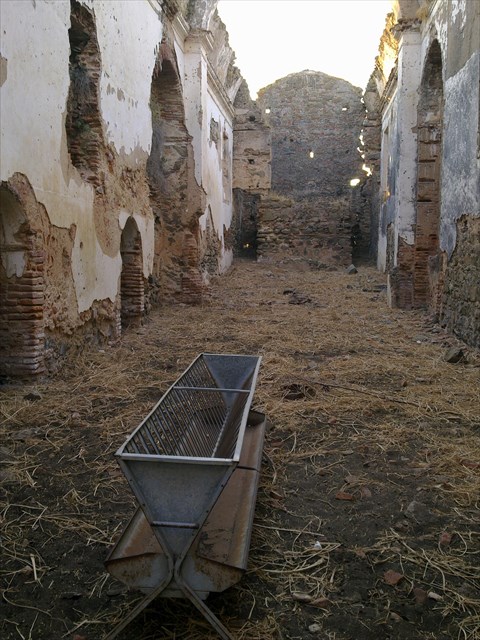

Ah, e não se esqueça nunca//Oh, and never forget: Cache In Trash Out!
Boas Práticas para um Geocaching melhor. Colabore!
- Ao decidir procurar uma cache faça-o de acordo com o que é pedido pelo owner. Respeite a sua vontade e as suas recomendações, pois delas dependem a sua integridade e a da cache. Não destrua, não parta, não deixe mais que pegadas e não traga mais que fotografias.
- Leia bem o página da cache antes de começar a busca. Pondere bem os riscos, e se o nível de Dificuldade e Terreno está de acordo com os seus limites e objectivos. Não ponha em risco a sua vida e a a da cache, e se acha que não é para si não arrisque e passa à próxima. Nem todas as caches são para todos.
- Lembre-se que o Geocaching proporciona-nos aventuras e leva-nos a locais que de outra forma não iríamos conhecer e visitar, por isso quando for procurar uma cache vá com tempo, quer para conhecer bem o local, mas também para estar preparado para algum imprvisto que possa ocorrer.
- Tenha especial cuidado ao procurar o esconderijo da cache, certifique-se que não há ninguém por perto ou ninguém a ver. Caso haja seja o mais discreto possível. Não arrique caso tenha consciência que está a ser observado, e desista. Certamente terá uma nova oportunidade para lá voltar, e assim evita que a cache seja objecto de buscas indesejadas.
- Ao encontrar a cache faça sempre um registo escrito no logbook. Se necessário use frente e costas das folhas do mesmo, poupe papel.
- O material de escrita que está na cache não é para retirar.
- Sempre que possível faça troca de objectos, mas coloque um de igual valor ao que retirou.
- Tire fotos, muitas fotos, e não esqueça de as colocar no seu log online na página da cache.
- Quando fizer o log online faça-o de uma forma detalhada possível de modo a dar a conhecer a aventura que a visita ao local proporcionou. Se houver alguma sugestão ou recomendação a fazer ao owner aproveite e faça-o no log. Precisa de manutenção? O acesso foi dificultado? Mudaram a cache de sítio? Qualquer situação que lhe pareça anormal comunique, informe o owner, seja por log ou através de mensagem privada.
|